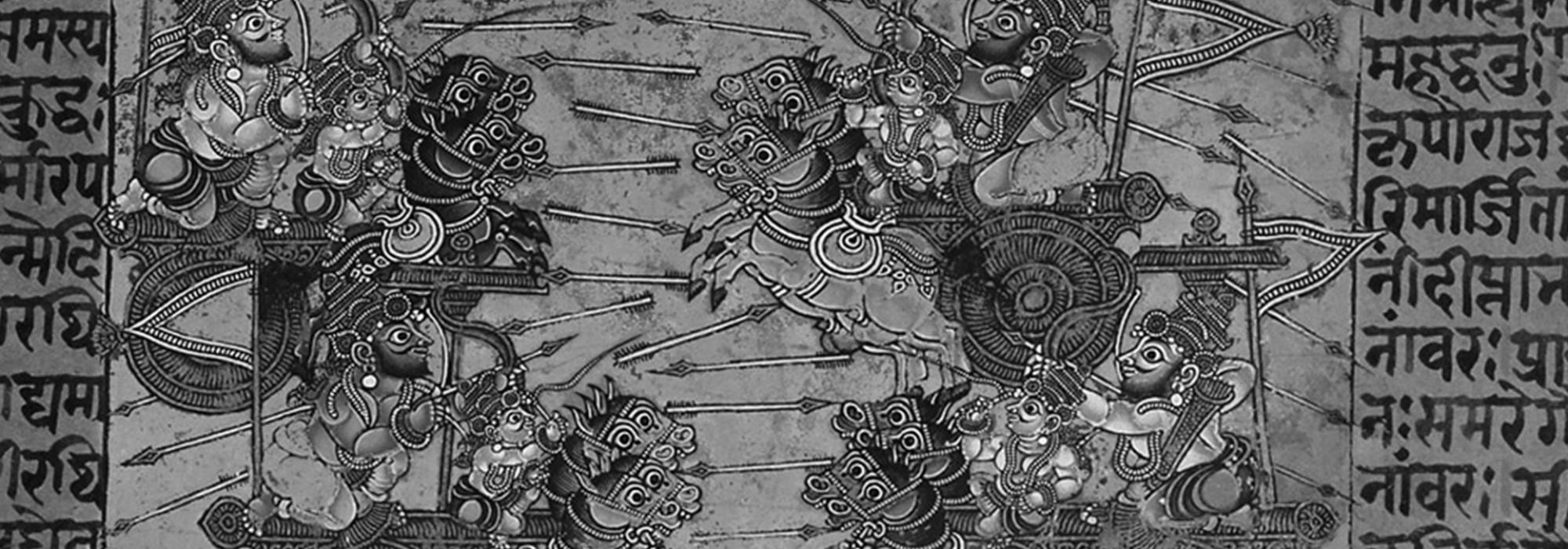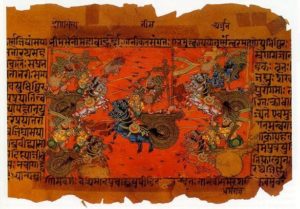In many ways, the Bhagavad-Gita is a unifying text. Krishna cuts across class distinctions, mocks at social prejudices, abhors outdated traditional practices, and finds convergence for divergent thoughts and beliefs. And in the process, he rattles the cage on several occasions.
No unification is possible without loss of individual identity – and this is not taken lightly by the various factions. Unification calls for not just revolutionary fervor but also flawless reasoning. Krishna seemingly instigates chaos in the heart of Arjuna and then brings order by the force of his impenetrable logic. The Bhagavad-Gita has many such ‘shock treatment’ passages where Krishna tries to shake Arjuna out of his stupor. Krishna gently mocks at the elite and the orthodox, and repeatedly claims that the religion of the Vedas is inclusive. Time and again, he talks of egalitarianism but with focus on the inherent strength of an individual. He challenges Arjuna to think differently and not to buy into traditional baggage.
Even to this day, it is hard for an orthodox brahmana, on his own, to teach the Vedas to one who is not a brahmana. Some years back, an orthodox brahmana had resigned from his position at a state-run Vedic school when the authorities insisted that he should teach the Vedas to anyone who wanted to learn. This is perhaps the effect of attaching importance to outdated traditions in the face of the eternal truth.
Krishna begins his shock treatment early on; he starts off by mocking at Arjuna at his foolish decision at a crucial juncture. Then he says:
You grieve for that which you should not, yet you speak words of wisdom. The wise do not grieve for the dead or for the living. (2.11)
Contrast this to Arjuna’s worry that the ancestors, deprived of the funeral and post-death rites, would land up in hell (1.42-44). Ironically, this view is upheld by many ardent Hindus even to this date. Down the ages, usually tradition tends to shake the truth, like a tail wagging the dog. It is noteworthy that Krishna declares that the essence of religion was lost over the years (4.1-2).
At one point, Krishna directly attacks the orthodox with his genial approach:
Those who lack proper insight delight in the letter and not the spirit of the Vedas and proclaim in flowery words, "there is nothing else other than this." (2.42)
They are filled with desires, and reaching heaven is their supreme goal. Caught in the vicious cycle of karma, they perform many elaborate rituals to attain pleasure and power. (2.43)
Those attached to pleasure and power, are led astray by that flowery language of the Vedas; they never attain the firm intellect of a contemplative mind. (2.44)
At the crescendo of his argument, Krishna presents a simple analogy that will not, hopefully, fail to clarify to Arjuna the importance of right living rather than mere reading.
What is the use for a well when there is a flood and water is flowing freely everywhere? What is the use of all the Vedas when one has realized the ultimate truth? (2.46)
It is important to note that Krishna was not opposed to the Vedas. He says in 15.15, “Realizing the supreme is the goal of all the Vedas; I am the source of the Vedas.” Basically, he wanted people to realize the higher purpose of the Vedas.
Later in the conversation, Krishna clarifies a huge doubt about the role of the divine in daily life. He says that it is foolish to hold god responsible for the acts of good and evil on earth. Whatever good and evil that we have on earth are just results of the actions that we have performed; why bring god in the picture?
God does not command people to act. God does not create activities or its associated rewards. All these arise from nature. (5.14)
God is not responsible for goodness or evil. People are deluded because their knowledge is clouded by ignorance. (5.15)
Krishna also evens out all the distinctions that exist in societies – be it ancient or modern. He presents an egalitarian approach and shows how external factors mean little when greater heights are reached spiritually. Societies typically look down upon certain sections of people. Krishna clarifies that whoever submits to the supreme attains liberation, irrespective of their birth, gender, or occupation.
Even if a man steeped in evil takes on to my worship with undivided devotion, he must be considered as noble because he has taken the right decision. (9.30)
Readily, he becomes righteous and attains everlasting peace. Arjuna, know this: no devotee of mine is ever lost. (9.31)
Whoever takes refuge in me – even men of sinful birth, women, traders, or laborers – will attain the supreme goal. (9.32)
Krishna often presents the idea that a wise person treats everyone equally. For example, a scholar is one who is generally held in high esteem in society while a person who eats a dog is considered to be at the lowest level. The wise notice the same inner spirit in all these beings irrespective of their external characteristics.
“A wise person treats everyone equally – a scholar endowed with modesty, a cow, an elephant, a dog, and one who eats a dog.” (5.18)
The pièce de résistance of the shock treatment verses comes in the concluding portion, when Krishna says,
Giving up all forms of dharma take refuge in me alone. I will liberate you from all sins, do not grieve! (18.66)
(Note: Here, dharma is used in the widest sense of the word – law, virtue, support, religion, duty, path, etc.)
This one verse basically puts all middlemen (purohitas, swamis, tantriks, babas, etc.) out of business. The connection is between the individual and the universe, between the individual and god. There is no need for a via media. There is no need, perhaps, for an organized religion. The sanatana dharma (eternal path) of ancient Indian thought was a way of life, and a path of self-illumination rather than a set of rules and rituals. And Krishna is the foremost among the upholders of this ancient tradition, and he didn’t think twice before rattling the cage to clarify the true meanings.
All translations from The New Bhagavad-Gita by Koti Sreekrishna and Hari Ravikumar. Mason: W.I.S.E. Words, 2011. This article was first published in Bhavan's Journal, 31 July 2012.

















































